
The Mikoyan-Gurevich MiG-15 is a jet fighter aircraft developed by Mikoyan-Gurevich for the Soviet Union. The MiG-15 was one of the first successful jet fighters to incorporate swept wings to achieve high transonic speeds. In aerial combat during the Korean War, it outclassed straight-winged jet day fighters, which were largely relegated to ground-attack roles. In response to the MiG-15's appearance and in order to counter it, the United States Air Force rushed the North American F-86 Sabre to Korea.

The USAF Air Demonstration Squadron is the air demonstration squadron of the United States Air Force (USAF). The Thunderbirds, as they are popularly known, are assigned to the 57th Wing, and are based at Nellis Air Force Base, Nevada. Created 71 years ago in 1953, the USAF Thunderbirds are the third-oldest formal flying aerobatic team in the world, after the French Air Force Patrouille de France formed in 1931 and the United States Navy Blue Angels formed in 1946.
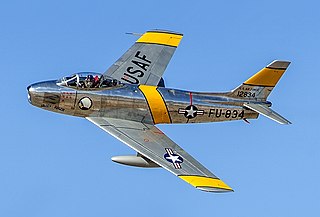
The North American F-86 Sabre, sometimes called the Sabrejet, is a transonic jet fighter aircraft. Produced by North American Aviation, the Sabre is best known as the United States' first swept-wing fighter that could counter the swept-wing Soviet MiG-15 in high-speed dogfights in the skies of the Korean War (1950–1953), fighting some of the earliest jet-to-jet battles in history. Considered one of the best and most important fighter aircraft in that war, the F-86 is also rated highly in comparison with fighters of other eras. Although it was developed in the late 1940s and was outdated by the end of the 1950s, the Sabre proved versatile and adaptable and continued as a front-line fighter in numerous air forces.

The SIAI-Marchetti S.211 is a turbofan-powered military trainer aircraft designed and originally marketed by Italian aviation manufacturer SIAI-Marchetti.
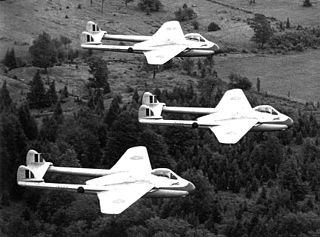
The Blue Devils or the 410 (F) Squadron Aerobatic Team was a Royal Canadian Air Force (RCAF) aerobatic team that flew the de Havilland Vampire jet aircraft from 1949 to 1951. The unit was the RCAF's first postwar aerobatic team, and belonged to the RCAF's first operational jet fighter squadron, No. 410 Squadron.

Kunsan K-8 Air Base (Korean: 군산공군기지) is a United States Air Force base located at Gunsan Airport, on the west coast of the South Korean peninsula bordered by the Yellow Sea. It is located in the town of Gunsan, about 180 kilometres (110 mi) south of Seoul.

The Canadair Sabre is a jet fighter aircraft built by Canadair under licence from North American Aviation. A variant of the North American F-86 Sabre, it was produced until 1958 and used primarily by the Royal Canadian Air Force (RCAF) until replaced with the Canadair CF-104 in 1962. Several other air forces also operated the aircraft.
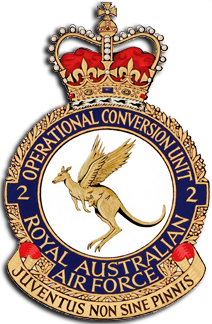
No. 2 Operational Conversion Unit is a fighter training unit of the Royal Australian Air Force (RAAF). Located at RAAF Base Williamtown, New South Wales, the unit trains pilots to operate the Lockheed Martin F-35 Lightning II. Pilots new to the F-35 enter No. 2 2OCU after first qualifying to fly fast jets at No. 79 Squadron and undertaking initial fighter combat instruction at No. 76 Squadron. Once qualified on the F-35, they are posted to one of No. 81 Wing's operational F-35 units, No. 3 Squadron, No. 75 Squadron or No. 77 Squadron.

James "Jabby" Jabara was the first American and United States Air Force jet ace. Born in Oklahoma, he lived in Kansas where he enlisted as an aviation cadet at Fort Riley after graduating from high school. Jabara attended four flying schools in Texas before he received his pilot's wings and was commissioned as a second lieutenant. Jabara flew two tours of combat duty in Europe during World War II as a North American P-51 Mustang pilot, and scored 1.5 air victories against German aircraft.

A fighter pilot or combat pilot is a military aviator trained to engage in air-to-air combat, air-to-ground combat and sometimes electronic warfare while in the cockpit of a fighter aircraft. Fighter pilots undergo specialized training in aerial warfare and dogfighting. A fighter pilot with at least five air-to-air kills becomes known as an ace.

George Andrew Davis Jr. was a highly decorated fighter pilot and flying ace of the United States Army Air Forces in World War II, and later of the United States Air Force during the Korean War. He was killed in action during a combat mission in northwestern Korea, in an area nicknamed "MiG Alley". For his actions during the Korean War, Davis was posthumously awarded the Medal of Honor and promoted from major to lieutenant colonel.

Antonio Marfori Bautista was an F-86 Sabre pilot who served in the Philippine Air Force. He served in the aerobatic display team the Blue Diamonds and fought against rebels in the south of the country. He was killed in action in January 1974.

Cesar Basa Air Base, or simply Basa Air Base, is an airbase currently operated by the Philippine Air Force. It is located at Floridablanca, Pampanga about 40 miles (64 km) northwest of Metro Manila in the Philippines. It is named after César Basa, one of the pioneer fighter pilots of the Philippine Air Force.

The 53rd Air Demonstration Group, nicknamed the Black Eagles, is the flight display team of the Republic of Korea Air Force (ROKAF) based at Wonju, Gangwon Province.
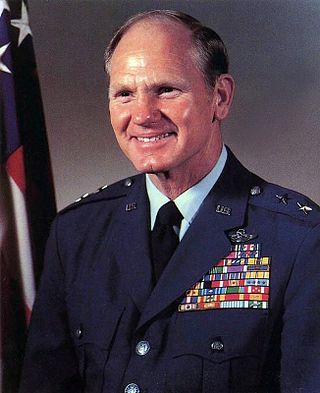
Frederick Corbin "Boots" Blesse was a United States Air Force major general and flying ace. He graduated from the United States Military Academy in 1945. He flew two combat tours during the Korean War, completing 67 missions in P-51s, 35 missions in F-80s and 121 missions in F-86s. During the second tour in F-86s, he was officially credited with shooting down nine MiG-15s and one La-9. At the time of his return to the United States in October 1952, he was America's leading jet ace.

The PAF Blue Diamonds is the national aerobatic team of the Philippine Air Force (PAF). Assigned to the 5th Fighter Wing, the unit is based at Basa Air Base in Floridablanca, Pampanga. Founded in 1952, the Blue Diamonds is one of oldest formal flying aerobatic teams in the world, along with United States Air Force Thunderbirds founded in 1953, the United States Navy Blue Angels formed in 1946, and the Patrouille de France of the French Air Force formed in 1931. The Blue Diamonds has been inactive since 2005.
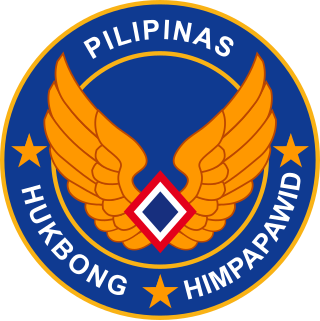
The Philippine Air Force (PAF) is the aerial warfare service branch of the Armed Forces of the Philippines. Initially formed as part of the Philippine Army as the Philippine Army Air Corps (PAAC) in 1935, the PAAC eventually saw combat during World War 2 and was formally separated from the Army in 1947 as a separate service branch of the AFP under Executive Order No. 94. At present, the PAF is responsible for both defending Philippine airspace, and conducting aerial operations throughout the Philippines, such as close air support operations, combat air patrols, aerial reconnaissance missions, airlift operations, helicopter tactical operations, special operations, and aerial humanitarian operations, which includes search and rescue operations. The PAF has also carried out various missions within the country and abroad.
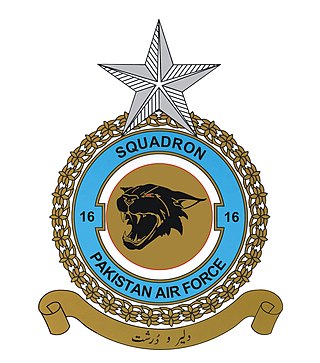
No. 16 Squadron, nicknamed the Black Panthers, is a multi-role squadron of the Pakistan Air Force's Northern Air Command. It is currently based at Minhas Airbase and operates the PAC JF-17 Thunder multi-role jets.

William Thomas Whisner Jr. was a career officer and pilot in the United States Air Force, retiring as a colonel with 30 years of military service. He was a fighter ace with Army Air Forces over Europe in World War II and a jet fighter ace with the Air Force in the Korean War.
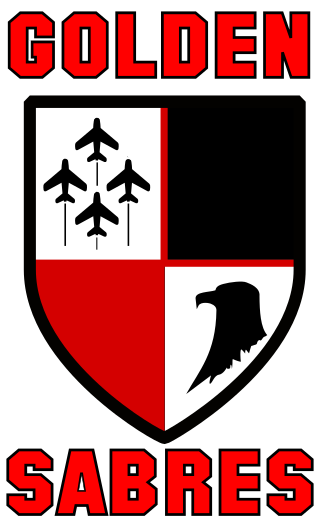
The Golden Sabres of the 9th Tactical fighter squadron were one of the Philippine Air Force's aerial demonstration teams.




















